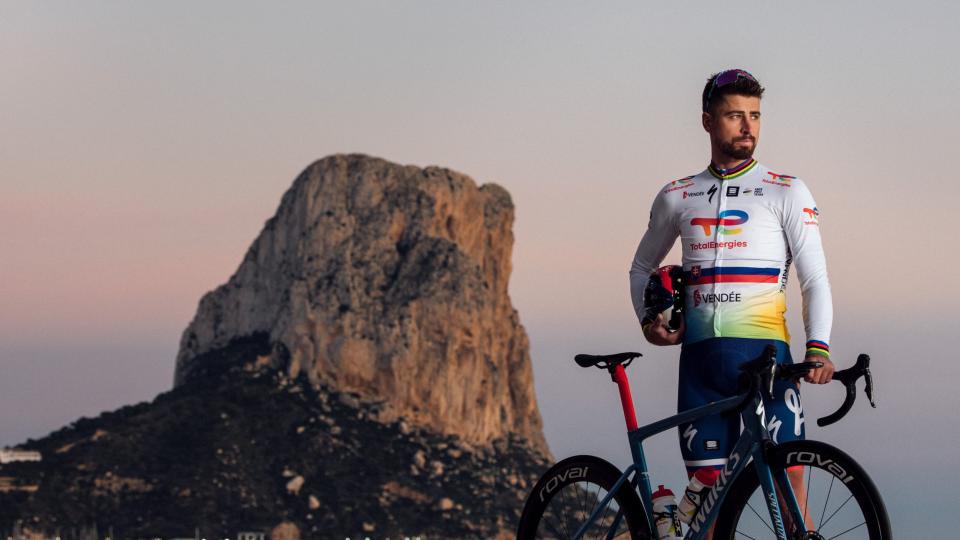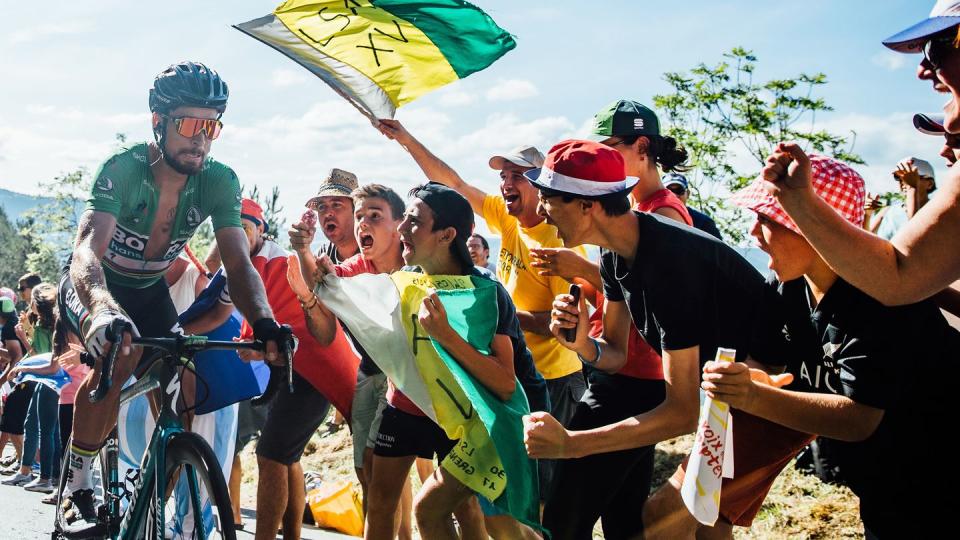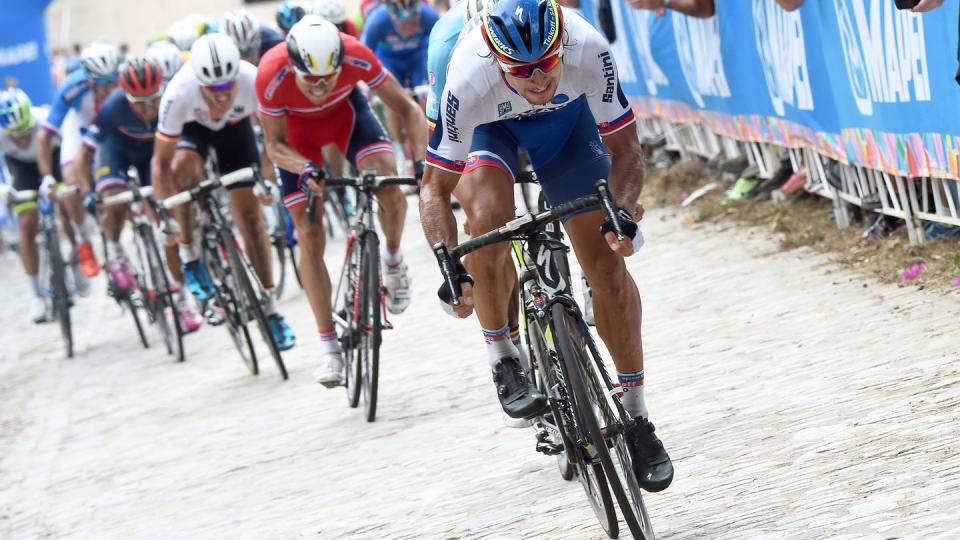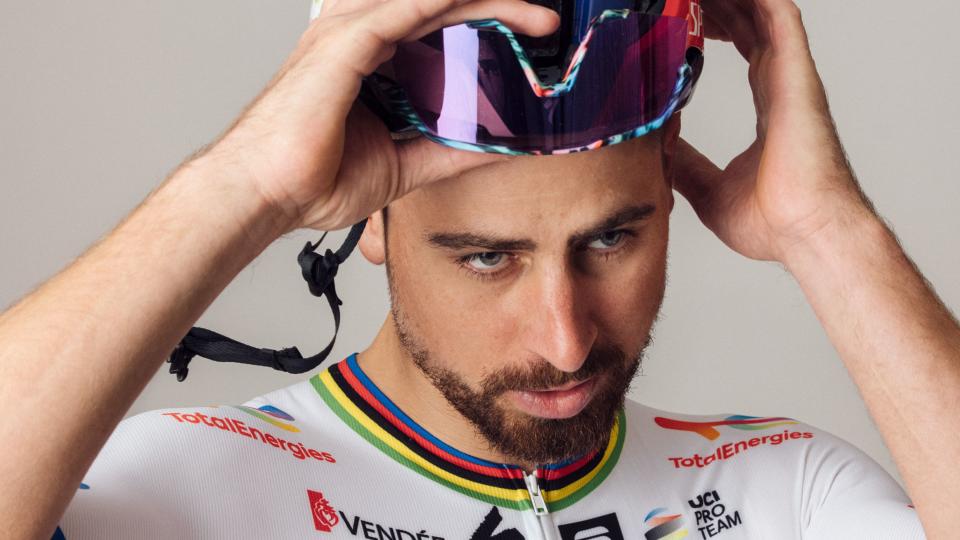For a Time, Peter Sagan Was Cycling’s Brightest Star. Could He Have Been Even More?

- Oops!Something went wrong.Please try again later.
- Oops!Something went wrong.Please try again later.
As the dark Mediterranean crashes outside his TotalEnergies team’s Spanish hotel, Peter Sagan sits back and sips a cup of tea. There are crow’s feet around his smiling blue eyes. The end is near and he knows it. On his final winter training camp, mornings are spent drinking espresso-machine coffees in cardboard cups before shaking his sculpted calves and riding off into the horizon. In the evenings, he shoots pool and the breeze with his teammates. Clad in his navy team-issue polo shirt, he might look the same as them from a distance, but everyone knows Sagan is different.
In a rocky period for professional road cycling—when doping scandals sullied the sport’s reputation—Sagan was the entertaining figurehead who breathed life into it. He is a genre jumper: an excellent sprinter, a fine climber on hills shorter than five kilometers, a demon descender, comfortable on the cobblestones, and one of the best bike handlers in the peloton. In his heyday, it meant he could fight Fabian Cancellara and Tom Boonen in the cobbled races, beat Mark Cavendish and Marcel Kittel in the bunch sprints, and even clash with climbers like Chris Froome in breakaways—always while playing to the crowd.
Join Bicycling for unlimited access to best-in-class storytelling, exhaustive gear reviews, and expert training advice that will make you a better cyclist.
His consistency was unbeatable in the Tour de France points competition between 2012 and 2019. His wins—121 in all, including three world titles, Paris-Roubaix, and the Tour of Flanders—plus his colorful personality assure his legend. It seemed like he’d never stop winning—or grow up. But even Sagan can’t outrace time. As the Slovak superstar retires from road racing, Bicycling charts the man beneath the victories, his career, and how he transformed cycling.

Sagan is quick to downplay his extraordinary abilities. “I am a general rider in that I am going slow everywhere,” he says, offering a firm handshake before settling into his chair. “I am not a climber. I am not a sprinter, you know?” But someone who isn’t a sprinter doesn’t win the green jersey seven times or 12 stages of the Tour de France, I reply.
“Well, I won the green jersey without winning a stage [sometimes], too. Because I managed to get the points where it was impossible for sprinters, that’s why I’m a general rider,” he says, warming to his theme. “I am not the best in any discipline. I am not a time-trialist, I am not a climber, I am not a sprinter. Maybe I can be good at descending.”
Sagan is a resident of the tax haven of Monaco. But the Slovak city of Žilina is the place that formed him. It is a crossroads city in the country’s far north, close to the center of Europe. Czechia and Poland are a short drive away. Thirteenth-century castle ruins cling to nearby cliff tops, and brightly colored Baroque houses surround the cobbled main square—a composition and palette that feels like the setting of a Wes Anderson film. On my visit, the whole town seems to be outside, chatting and drinking steaming cups of mulled wine at the Christmas market, a few steps away from the staircases Sagan used to casually ride down as a teenager.
Born in January 1990, four weeks after peaceful protests swept through Czechoslovakia and signaled the end of Communist rule and the country’s dissolution, Sagan is a child of the Velvet Revolution. He is the youngest of four children of L’ubomír Sagan and Helena Saganová, growing up in a small house on a dead-end street in the southern suburb of Bôrik. Their grandmother also lived with them, with the home extended to accommodate all seven of them, and for most of Peter’s childhood, he shared a room with his brother Juraj, who was 13 months older. The eldest sibling, Milan, had dreams of playing ice hockey, but the family couldn’t afford it. “He always pushed us to be better, to compete at the highest level,” Juraj says of Milan. “Saying ‘I didn’t have this chance, so brothers, you have to do it.’”

The family ran a small grocery store before purchasing a couple of pizza joints in Žilina. Juraj and Peter would put the dough in the oven and do rounds of promotional leafleting; Peter once said if he stopped winning, he’d become a pizza delivery driver. It was Juraj who first tried cycling after their Aunt Marta inquired with the local club, CyS Žilina. At the time, Peter was dabbling in soccer, but would soon follow. Where Juraj led, his younger brother was often drawn.
One of their first coaches, Peter Zánický, whom Sagan respectfully still calls tréner (coach), has a faded club photo in his memorabilia-strewn garage. The two boys, small and pale, stand in the front row in their yellow-and-green jerseys. Zánický remembers taking the club’s youngsters on a training session in Žilina’s wooded Lesopark. On the trail, a pair of trees stood with barely a meter’s leeway between them. Riding between them was inconceivable to Zánický, who suggested the group go a different way. Suddenly, there was Peter barreling down at speed. Zánický shouts while retelling the story as if reliving his panic. But his protégé swiftly maneuvered his handlebar between the trunks. “No fear,” Zánický says.
Sagan had the character to go with the nerves. During one of his first races, a 1999 Slovak Cup mountain bike event, Zánický saw him crying at the start, left behind by the pack. He had crashed and thought his race was over. Zánický offered him a few words of encouragement, and Peter rode off, sobbing. At the finish, he jumped into the final corner and snatched a narrow victory. “And then I realized Peter has a winner’s heart,” Zánický says. “He’s a bulldog.”
Excelling on two wheels, the Sagan brothers attended the local sports school along with a friend, Michael Kolář; all three would go on to race together on the WorldTour. However, the arrival of a printer in the Sagan household was almost a spanner in the works. It meant Sagan and Kolář could fabricate absence slips signed by a fictional trainer. “Saying that we’re at training camp or whatever,” Kolář says. “In reality, we were just sitting in Peter’s bedroom playing PlayStation.”
In their teenage years, Juraj was more obsessed with the sport than his younger brother, reading cycling magazines, going to a friend’s house to watch the Tour de France, and encouraging them to go training. He has been a lifelong reference point for Peter; from 2010 to 2022, they raced together on the same professional teams—Juraj as a loyal worker until his retirement. “There was just one period where I started to be a bit jealous,” Juraj says. “But it was more about Peter’s technique. He was mad on the bike: He did crazy jumps, [while] I was scared. For him, it came like this,” he adds, clicking his fingers.
Peter split his time between the tarmac and the trails. At the age of 14, he called Zánický and told him his road career was over: He wanted to be a downhill mountain biker. That was until his father watched a race and said he could forget about it because he wouldn’t give him the money for a bike.
Meanwhile, Sagan had interest from road teams, and there was more money to be made there. He started racing around Europe, though Peter only got on his first airplane at the age of 17. “Now, the doors are much more open,” he says. “I remember how hard it was for me to learn Italian and English, and my son is already talking French, English, and Slovak.” When his phone lights up with a new message, it reveals a photo of 6-year-old Marlon as the background.
His farewell to full-time mountain biking was in Italy at the Junior Cross-Country Mountain Bike World Championships in 2008 in Val di Sole, where he won his first rainbow jersey. As he crossed the line, he turned back to the horizon with a hand on his forehand, cheekily looking for the rest of his competitors. The bike had become an extension of his personality, a way of showing his charisma. “In cycling, he has to be funny for the people,” Juraj says. “He wanted to always do good things for them, to show cycling in a different way.”

There’s a quote, commonly attributed to Tolstoy, which says there are only two plots in literature: a man on a journey or a stranger coming to town. As 19-year-old Sagan set out into the world of international cycling, he was doing both.
While absent-mindedly playing with the jam pot that accompanies his tea, Sagan casts his mind back to December 2009 and his first training camp in the Spanish resort town of Benicàssim, with the leading Italian team Liquigas. “Everything was new, I was young. I enjoyed it much more,” he says. “There were no interviews, photo shoots, and stuff like that. I was only on the bicycle, and after, the focus was on recovering. Now, it’s from everything [to] something.”
Back then, Sagan says, he had no expectations. The only road racers he knew were Lance Armstrong, Jens Voigt, Marco Pantani, Mario Cipollini, and his favorite, Jan Ullrich. At his first pro race, the 2010 Tour Down Under in Australia, he crashed and got 18 stitches, finished third on a stage, but also finished just off the podium on a stage won by Luis León Sánchez. “After Australia, I understood that between winning and being fifth is not that big a gap. [Then], I started to believe I can win some races,” he says.
It didn’t take long. His friend and teammate Daniel Oss remembers turning on the television two months later to see the unheralded newbie out in front, holding off the peloton alone in Stage 5 of Paris-Nice with a late attack. “Winning with him was beautiful.… like when someone starts the electric guitar, and they say, ‘Okay, this is rock ’n’ roll.’ Everybody is listening, but nobody knows [what it is],” Oss says.

Oss was by his side for his first three Tour de France stage wins in 2012 and the green jersey title. That debut appearance launched Sagan as both an exceptional talent and a personality above the rest. “He did everything with such a light mindset, such softness. Everything was fun,” Oss says. When he won the first stage, he did the Chicken Dance because he had a bet with friends at home, adds Oss. And after another bet and win in the green jersey, Sagan said, “I do it like Forrest Gump. When they told him to run, he ran. When they tell me to win, I win.” Popping wheelies, skidding around corners, and scooping up victories, he made cycling look like a video game, moving through the peloton like a two-wheeled Pac-Man—though his brash style made him controversial in the bunch for his habit of chopping others into corners or taking unnecessary risks on descents.
Those early years in lime green Liquigas kit were unpredictable. There were the highs: a victory in a grueling mountain stage of the 2011 Tour of Switzerland and sprinting to four consecutive Tour of California stage wins in 2012. And the lows: second place at the 2013 Tour of Flanders blighted when he pinched the bottom of a podium presenter and by the (deserved) scorn that came with it.
His prolific win rate—more than 50 in his first four years—masked the development journey he was on. “When you are winning, you are not going to learn anything,” he says. “You have to lose to learn something.” His Liquigas coach Paolo Slongo said in 2012 that if he had the right maturation and weight loss, he could become a Grand Tour rider. “Ah well, I never had that in my head. I was already doing a lot of sacrificing for cycling. Why change something that is working well?” Sagan says. “If I have to go for a Grand Tour, I have to lose eight, nine, 10 kilos… I prefer to have three world championships than one Tour de France [win].”
For all his skills, recognizing his limits has been essential to his success, too. “A sprint is not painful,” he says. “You have adrenaline, you don’t think about pain. It’s what, two minutes, three minutes? If you have to climb for one and a half hours, that’s more painful.”
With talent like his, Sagan should have won more of the sport’s five Monument one-day races than a single edition apiece of the Tour of Flanders and Paris-Roubaix. Milan-Sanremo always eluded him; he was second twice, and fourth five times in the marathon Italian race, losing on a bike throw in 2013 and 2017. “If you are super good, [in] Flanders and Roubaix, you can win because of the legs,” Sagan says. “And you don’t win Milan-Sanremo because of the legs. I lost it a lot of times when I was the best on the day.”

“He was probably the strongest, but not the smartest,” says his former coach Javier “Patxi” Vila, who worked with him between 2015 and 2019 at Tinkoff-Saxo and Bora-Hansgrohe. “Also, there’s the way he likes to ride with his heart. Sometimes, that goes against achieving your goal. But I think that’s also why people love him so much.”
What surprised Vila most was all the things Sagan could do besides riding a bike. “He was an athlete, not just a bike rider,” he says. He mentions his proprioception—control and awareness of his body, knowing where every bit of it is. “And he would just die until he could achieve every athletic challenge. The other thing is how open-minded he is. For him, everything was an option.” Before the Spring Classics, he would go skiing at the Spanish resort of Sierra Nevada in February while training, not skipping one cycling session, even if it meant driving an hour down to the sea. The proof was in the results. “We broke some rules of cycling that were crazy until that moment,” Vila says. “It was fun to coach him.”
Sagan’s body language on the bike exudes calm and confidence; he corners with the precision and commitment of a racing motorcyclist. But he thinks differently, too. His favorite question is “Why?” Take the 2016 Olympic mountain bike cross-country race, where he started at the rear of the pack because he lacked ranking points. Rather than bunching up with the others, he put himself a few meters back, meaning he could tear past his competition with speed from the gun. When everyone goes in one direction, I’ll go in the other. And within half a lap, he was up to third place.
For several years, Sagan was a young king lacking a crowning one-day win. His 2015 Road World Championship title in Richmond was a career turning point after a season marred by back problems, heightened pressure, being knocked out of the Vuelta a España by a motorbike, and a rigorous, numbers-led coaching plan he didn’t enjoy at new team Tinkoff-Saxo. “He was best when left to his own devices, more or less when left playing on the bike. It was obvious he was just a kid who enjoyed having fun on it. As soon as it became systematic, it had a negative influence on him,” says his then-teammate, Chris Juul-Jensen.
That day in Virginia, Sagan gambled: When he could feasibly have waited for a bunch sprint, he went all in by going all out for three kilometers, attacking on the 23rd Street climb and then bombing the downhill. At the finish, he tossed his helmet, sunglasses, and gloves into the crowd, the only time he’s ever done that. “Everything just dropped off from me. I won the World Championships and I think it was nice also for people to have some gifts from me,” Sagan recalls. He ranks it as his favorite win, though he puts his three consecutive world titles together.
You might think that once at the top, a world champion would double down and train harder. Get even more serious. But that’s not Sagan. He used it as a license to be more unpredictable, starting with a postrace interview in which he highlighted the global migrant crisis problem. “Our generation has jumped too far ahead. We don’t know how to live in this time that we live in. This is important for all of us, otherwise soon everything will be finished,” he said of his comments later. “I just wanted to say to the world if I won the title: ‘Wake up, or it’s going to be too late.’”
We’ve not heard such stirring awareness of societal issues from him since. Sagan can be like an actor inhabiting various roles: the surprise spokesperson, the showman, the enigmatic press conference operator (sample quote: “How will be, will be. It is not in my hands.”). The same goes for his differing appearances, going from long-haired surfer dude to bearded hippie and brooding skinhead. As soon as you think you know Sagan, he changes again.

“He’s just being himself, right? He’s not thinking about giving one-word answers to the media after winning one of the biggest bike races in the world,” says his friend Michael Kolář. “He doesn’t give a shit. He grew his hair, he cut it, he didn’t shave his legs,” he says, referring to the 2016 season when Sagan turned up at the first races having forsaken the sacred ritual.
I wonder whether we ever get the real version of Sagan. Before delivering a bon mot to me, he’ll give a little smile to himself or cock his left eyebrow slightly. He knows how things play and sound. Being Peter Sagan can also be an act. “I think everybody is acting in the little things. Every day, you have to act in front of the people,” he says. So, is he acting now? “No, everyone has to. Sometimes, if you’re in a bad mood, you have to play that you’re in a good mood. You have to forget your problems and be present with the people. That’s acting.”
Only those close to him know that when he won one of his biggest races, he had to act. Crossing the line triumphant at the 2016 Gent-Wevelgem, you wouldn’t have a clue that his father-in-law had suffered a heart attack the previous day. He pretended everything was fine (his father-in-law eventually recovered).
There is a cinematic influence evident throughout Sagan’s career. He thumped his chest like Matthew McConaughey’s character in The Wolf of Wall Street after finishing second in a 2015 Tour de France stage. He got a tattoo on his torso depicting him as Heath Ledger’s Joker along with the words “Why So Serious?” He had to be persuaded to use a stunt double to jump through a window like Jason Bourne in one Specialized commercial because he so badly wanted to do it himself.
He even received coaching from an actor during a training camp in 2017 at Lake Tahoe around the Tour of California. It was a lot more method acting than he realized; Kolář recalls bursting into laughter as Sagan told them about one exercise that had him rolling in the dirt and growling like a bear.
Sagan looks a little embarrassed when I mention it. “It was more to have a different point of view on things and to try some new experience,” he says. His press manager and confidant Gabriele Uboldi says Sagan had chances to be represented by acting agencies and had conversations to star in a biopic film about his life, but it wasn’t the right time. Sagan believes he’d need to go to school and improve his English, things he has no time for. For now, he’ll have to make do with watching his favorites, Leonardo DiCaprio, Brad Pitt, and Tom Hardy, on the silver screen. “Maybe my son could be an actor,” he adds. “I prefer he’d do that than be a cyclist.”
His face and flair have been bliss for brands like 100%, Sportful, and Specialized, with whom he has long-term associations. On Instagram, until recently, he had more followers than the Tour de France. Such a high profile is no accident. The core business team around him—right-hand man Uboldi, agent Giovanni Lombardi, and PR and communications officer Pierre Orphanidis—have helped turn him from champion cyclist into global brand. “Peter has the advantage—or the disadvantage, depending on how you see it—of coming from a tiny country; Slovakia has a population of 5 million,” says Orphanidis, who also runs his social media. “You have the opportunity to build a true world star. Someone that has, let’s say, no nationality.”
Nevertheless, Sagan’s life involves the adulation of a movie star, besieged for selfies whether filming a bike commercial in a remote Colombian village or racing on the world stage. (He even signed a copy of his autobiography for a fan running alongside him while climbing the Col du Tourmalet during the 2019 Tour de France.) Like a motto, Uboldi sometimes says to him, “viviamo per la gente” (we live for the people). But those close to Sagan are unanimous: They wouldn’t like his intense life. “The race is the last problem. It’s really freedom for him because the schedule after cycling is full,” Oss says.

Sagan became cycling’s box office draw while the sport’s reputation was circling the drain. At the end of 2012, the U.S. Anti-Doping Agency revealed Lance Armstrong’s performance-enhancing drug use, and the Texan was stripped of his seven Tour de France titles. Several other past stars subsequently confessed their use of banned substances. Prominent team sponsors dropped out, unwilling to be potentially tarnished by association. For several years, Tour de France press conferences were spiky, adversarial affairs, suspicion particularly directed at Team Sky and their incumbent leader, Chris Froome.
The Slovakian was an invigorating antidote to their calculated tactics and the more toxic elements of the era. The first rider born in the 1990s to win a Tour de France stage belonged to a new generation. He charmed and excited fans. However, a powerful aura is no free pass when it comes to credibility. Does Sagan think doping is still going on?
“Even thinking about that is just stupid now because [the testers] have been [at the hotel]. You have an app to say where you’re sleeping every night. Under this system, it’s stupid to risk something, because you’d lose everything.” Sagan says he was tested “six or seven times” at home in the 2022 season, but has done 50 to 60 tests some years after races. “They’re coming much more when you’re winning,” he adds with a smile.
So there’s never going to be a Sagan positive? Fans can rest easy? “I hope so,” he says. “Well, everything is possible. You use a cream or something and become positive from stupid things.”
Winning one race per year was his initial goal. But when he won five on his first year racing professionally, he was more than pleased, hinting that he never really felt a need to look for that silver bullet. “If I manage to win one, two, three races every year, my season will always be good,” he says. “And up to now, I did that. You have to start from small things to make big things, right? This I have in my head: I managed to win when I was young, and I’ll do it older, but never with doping. Because really there’s no sense to take something.”
As he mulls over his career, it raises another question: Does he still love cycling the same as when he turned pro? “Differently,” he says with a laugh. “When I was 20, after my first year as a pro, I said I’m going to ride until my thirties and stop my career. I don’t want to ride on the bike into my forties. And now, we are here. I’m 33, and I’m still on the bike.”
On January 26, 2023, his 33rd birthday, he announced his retirement from the WorldTour after the 2023 road season. (He gave his closest entourage only four hours’ notice of the decision.) His aim is to target mountain biking at the Paris Olympics in 2024. “Why sad? It’s not like I’m dead,” he told one journalist after announcing the news at the Vuelta a San Juan.
A hint of his unfinished business came from his greater immersion in the off-road scene in 2022, racing Unbound Gravel in Kansas, as well as the gravel and E-MTB World Championships. “It was like the old times. I passed 12 years and turned back to the mountain bike world,” he says of his time at the latter race in France. “It was very beautiful for me. Nice to turn back for five days.”
During Sagan’s long goodbye on the asphalt, he is no longer the lone poster boy. “Now, there are also big names, [Mathieu] Van der Poel and [Wout] Van Aert, who are being watched more than me. I’m in a different position than before,” he says. In his final two years, Sagan never looked likely to beat his younger rivals in the races where he’d once been a habitual contender. What’s changed? His former coach Zánický and brother Juraj suggest he has the same power numbers as in his heyday. “No, even higher,” Sagan himself corrects. The best of his career, Uboldi interjects. “There’s the new generation, that’s how it’s going,” Sagan says.
You sound like an old guy, I say. “Well, I am already. In cycling,” he replies. He attributes the shift to the structure of every squad and the WorldTour teams’ coaches: “I think the general group level has grown. Before, it was individuals: I am strong, you are strong, and three or four of us are going to fight in the final. Now, all the group is going fast. That’s the thing. The power of the peloton, everybody is at the same level.”
Then there are off-the-bike events, such as his divorce from Katarína Smolková in 2019. “It was hard on him. That changed him, I’d say,” says Kolář, adding later: “Peter’s a person that commits 100 percent to things. And he’d never fallen in love, but with her, he did. Suddenly, he committed 100 percent, and after a few years, things didn’t go the way they both expected.”

COVID-19 also hit Sagan hard. The most damaging of his three positives came in early January 2022. After the fever, muscle pain, and dizziness subsided, long-Covid symptoms lingered. “I started to feel I was not able to race,” he says. “I had this very strange feeling in my legs, like pain. Even going slow on the bike, I constantly felt it.” It meant that the long training hours he’d banked in November and December were rendered worthless. It was a year of chasing lost time; he was a few short steps away from stage victory at the Tour de France, but a giant leap away from his former dominance. Just before the 2023 edition, he made more headlines from the prerace announcement of a suspended jail sentence for drunk driving, only registering one top-10 stage finish. One more flash of his brilliance would have been an apt sign-off, but as Sagan told me before Paris-Roubaix this year: “I have nothing to prove.”
There are plenty of predictions about what he will do after cycling: live on an island in Thailand. Race enduros. Dedicate more time to his son, Marlon. Be a sponsor ambassador. (That one seems guaranteed; his deal with 100% is not due to finish until 2040.) Asking Sagan himself is a fool’s errand. “Who knows what is going to happen later?” he says.
The Slovakian has come a long way from the kid who worked in the family pizza joint and didn’t get on a plane till he was 17 years old. Fame, seven green jerseys, three world titles, nearly two million Instagram followers, a contract worth an estimated €5.5 million a year, a Monaco apartment, fatherhood. An unquantifiable rapport with a generation of cycling fans. It changes a man.
You Might Also Like

